The Role of Artistic Environment in Enhancement of Creativity of Students in Case of Iran
Mohammad javad Mahdavinejad1 , Sonya Silvayeh1 and Seyyed Mojtaba Mirhosseini1 *
DOI: http://dx.doi.org/10.12944/CWE.10.Special-Issue1.36
Schools are places to train the next generations, thus for having a creative generation in future, schools environment have to encourage creativity. The goal of this research is surveying of the impact of art and artistic activities on students' creativity. The most important question of the research is: Does the use of artistic forms in school affect creativity of students? How? The relationship of artistic environment and creativity of students has been evaluated by use of empirical and semi empirical methods. Research achievements show that artistic environment affect creativity of students. But, this impact is not scalar, and indicates incompatibilities in some states.
Copy the following to cite this article:
Mahdavinejad M, Silvayeh S, Mirhosseini S. M. The Role of Artistic Environment in Enhancement of Creativity of Students in Case of Iran. Special Issue of Curr World Environ 2015;10(Special Issue May 2015). DOI:http://dx.doi.org/10.12944/CWE.10.Special-Issue1.36
Copy the following to cite this URL:
Mahdavinejad M, Silvayeh S, Mirhosseini S. M. The Role of Artistic Environment in Enhancement of Creativity of Students in Case of Iran. Special Issue of Curr World Environ 2015;10(Special Issue May 2015). Available from: http://www.cwejournal.org/?p=108
Download article (pdf)
Citation Manager
Publish History
Select type of program for download
| Endnote EndNote format (Mac & Win) | |
| Reference Manager Ris format (Win only) | |
| Procite Ris format (Win only) | |
| Medlars Format | |
| RefWorks Format RefWorks format (Mac & Win) | |
| BibTex Format BibTex format (Mac & Win) |
Article Publishing History
| Received: | 2014-11-06 |
|---|---|
| Accepted: | 2014-11-06 |
Introduction
One of the obvious differences between animal and human is creativity. Perhaps God gave human ability of being like himself with the knowledge that has gotten to human. One of the sides of human's likeness with God is the human's power of innovation and creativity. Development and human progress is due to intellectuals' efforts and their creativity. If researchers want to compare and evaluate communities in aspects of ability of creating positive changes in scientific, economic, social, technical and cultural fields, a country that can train creative people will obtain better rank. Creativity, as a science, is considered a key factor in the development of communities. Since creativity can be taught and learned, so we can foster creative people with creating conditions, equipment and facilities. In this meantime, school is a good place to train students to be creative (Cheraghcheshm, 2007). It should be considered that everybody has creativity inherently but education can lead to making it flourish. If this hypothesis be a criterion of this research, it is needed to train more than be talented to making it flourish (Pirkhaefi, 2000). This point shows that creativity is a controversial concept.
Concept of creativity is very important and complex. It is nice because it's a divine talent and the most important likeness of human and God. It is important because it's the only means of overcoming the problems of life and environment and the best way to prove oneself. In general, beauty of the subject of creativity on one hand and its importance in achieving success in work and life on the other hand, always invites a lot of people to the study of its literature. But dispersion of its contents and its complexity cause dissatisfaction of results of this study. Reason of this issue, regardless of variety of ideas about creativity, is its multi-dimensional nature (Soleymani, 2006, 9). By paying more attention to the importance of education in the future of the country, the importance and necessity of subject will be specified better.
In creative teaching method teacher should not teach students the knowledge but should provide a background that their students can gain knowledge and wisdom. This type of training programs should be designed in a way that the student is forced to experience and discover new points in different fields consecutively. Meintjes and Grosser's research shows that teachers themselves need to be creative thinkers in order to design appropriate learning programs and to nurture creative thinking abilities among learners (Meintjes and Grosser, 2010). They must construct experiences and assessment tools to assist learning in learners with diverse needs and interests and/or adapt existing experiences to suit the needs of their specific learners and situation. An issue that is important in this context is that often there are no appropriate conditions for student to see and understand. For each student creativity and intuition is provided in special circumstances and in the face of certain stimuli. Creative teaching method must make opportunity and be opportunist. Every moment of presence of student can lead to gain a great knowledge and create a great work (Hojat, 2004). This concept is mentioned "Intelligent Education" in some sources.
Necessity of creativity can be considered from two dimensions: 1. Material dimension 2. Spiritual dimension. In material dimension, the importance and necessity of creativity is in some extent that it is said so called "or death, or creativity" and man is called creative animal; so man without creativity is animal. In general, in material dimension can be said that if we look carefully at surrounding issues, we will see the necessity of creativity obviously. But unfortunately, despite of necessity of discussion about creativity, there are no formal courses in Iran's universities and training centers with this subject.
Creativity and Creation
The Concept of Creativity
There are numerous and sometimes conflicting definitions about the concept of creativity and "there is no universal agreement on what creativity actually is" (Wallace, 1986, 68). Definitions of creativity differ, but they have in common their emphasis on people’s ability to produce products that are not only high in quality but also novel (Sternberg, 2001, 360-362). One of the methods of developing creativity is Brain Storming method. In this method teachers allow students to develop their creative thinking. This method is used to increase flexibility of mind in order to create more and of course new ideas. So students have an opportunity to think deeply in calm and free of any kind of threat and stress atmosphere. After considering various aspects of an issue, they propose their answers freely and far from any judgments (Behruzi, 1995). There are some other methods for developing creativity that effect on students' creativity and are proved in various experiences (Figure 1).
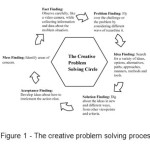 |
Figure1: The creative problem solving process |
Creativity in Theories
Creativity is based on several theories. One of these theories is investment theory of creativity that Sternberg and Lubart have proposed in 1995. They believe that creative people are like good investors. Investors are trying to buy cheap and sell expensive, i.e. have a good profit from their work. Creative people also are trying to take advantage of thoughts and ideas that are considered by others less and create new phenomena by innovating them (Raeesdana, 2009, 21). Other definitions of Creative thinking include: (1) creative thinking involves the collaboration of a person’s imagination, cognitive abilities, and the whole personality (Morgan and Foster, 1999); (2) creative thinking is a dynamic mental process and includes both divergent and convergent thinking (Guilford, 1956); and (3) creative thinking involves different "facets" of creativity including the creative process, the person, and a solution (Mackinnon, 1965). Albert Rennet George says: "Creativity is a different view to the phenomenon that other people also see them." William J. Reef writes: "Creativity is an acquired reaction against situation that comes from data and other necessary resources for an issue" (Seyyedjavadin and Karami, 2007, 14). De Bono with a cognitive view to the creativity, cites lateral thinking theory for explaining creativity that is similar to divergent thinking in Guilford and Torrance theory. De Bono believes that vertical thinking can be proposed besides lateral thinking. He believes that vertical thinking causes creating mental frameworks and developing them, while lateral thinking changes the structure of these frameworks and creates new ones. According to Sternberg's theory that has done in 1995 based on "Investment Model of Creativity", creativity requires six different and relevant resources: 1. Intellectual Processes 2. Knowledge 3. Intellectual Style 4. Personality 5. Motivation 6. Environmental context (Sadeghi and Raeesi, 2010). In Prince's viewpoint innovate thinking is typically an unusual thinking (Hosseini, 2008, 24). Torrance in a comprehensive definition of innovative thinking process, believes that innovative thinking is process of sensing problems, difficulties or gaps in data, guessing and making hypothesis about these deficiencies, evaluating this hypothesis, revising and reevaluating them, and finally transferring the results.
Research Background
From past years, there has been proposed a few issues about creativity in Iran. In recent years some researches have been done in the field of creativity, but most of them are in affective-cognitive field of creativity and there are a few considerations in the field of the architecture and the effect of environmental quality in enhancement of creativity (Shafaee and Madani, 2010). On the other hand, one of the basic goals of Iran's educational system has been planned to foster students' creativity, but despite of the importance of this issue, it has been paid much less for researching and planning about fostering students' creativity. So this research is going on to find the effect of environmental quality in enhancement of the creativity of the students.
Basis of Creation
Creation is a creativity that leads to create a new element. Mahdavinejad's studies shows that for developing students' creativity many strategies have been proposed that the most of them can be divided into these 4 categories:
- Creation based on innovative person: In this approach person's individual characteristics is considered.
- Creation based on mental process: In this approach innovative person's mental process that cause creation is considered.
- Creation based on environment: This is the most important factor of formation of innovative thoughts.
- Creation based on doing the work: In this approach doing the work continuously in order to achieve innovation is considered (Mahdavinejad, 2005).
One of the scientists that has done a lot of researches and has theorized about creativity is E. Paul Torrance. He has three definitions for creativity in his newest comment: a research definition, an artistic definition, and a definition depends on survive. In his research definition creativity is: "process of sensing problems, difficulties or gaps in data, guessing and making hypothesis about these deficiencies, evaluating this hypothesis, revising and reevaluating them, and finally transferring the results" (Alavy, 2005, 45). Torrance has noted these items in his artistic definition: Creativity is like wanting to know. Creativity is like digging deeper. Creativity is like looking back. Creativity is like smelling the odors. Creativity is like handling the errors. Creativity is like cutting corners. Creativity is like singing in your style (Torrance, 1992). He in definition depends on survive has said that creativity is coping with difficult situations. In time of dealing with difficult and dangerous situations, "when a person does not have any pre-learned and pre-practiced solution, he needs some creativity" (Alavy, 2005, 46).
Factors of Creativity
For expressing factors of creativity, several categories have been presented so far. In one of the best of them, Soleymani lists these factors for creativity in this order:
- Fluidity: For creativity should have a fluid mind. In other words, mind should be able to create many ways for each problem.
- Development: Creating an idea is a big success, but the greater success is that you can develop your idea and change it to a full product with spending time on details and sub-elements.
- Synthesizing: Creativity in every topic, always has a kind of synthesizing in its heart. Many new and creative ideas are result of creating connection between ideas and other elements. What happens in synthesizing is creation of a new element that has something more than its components.
- Initiative: Creative ideas often are found among strange and unexpected exudations of mind. Creative mind thinks differently and moves through unusual and unexercised ways. To understand the nature of initiative and implement it, you must learn to be deconstructivist, look at issues differently, and pay more attention to the most impossible and strangest ways.
- Imagination: it's a part of the thinking that goes beyond the bounds of reality and makes possible something that is impossible. Having a powerful imagination means access to a rich and endless source of ideas and innovative concepts that human's talent of creation is fed by it.
Analysis: By use of analysis skills can do some work: 1. Breaking down an idea or work in order to access its component elements. 2. Surveying the connection between components and interaction of one part with other parts. 3. Identifying ideas of each product that actually have the main purpose of that one. Analysis as a skill of creativity is innovative critic of data (Soleymani, 2006) (Figure 2).
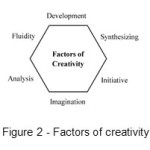 |
Figure2: Factors of creativity |
Art and Creativity
Creativity is one of the main directions of researches that are related to the art. Undoubtedly, any changes that occur in contemporary art have always focused on creativity and mental stimulations. It can be said that art is creativity. It has a strong educational function that gives a new perspective to persons and revised their relationship with other persons or things, and makes them to research and find new ways of analysis and new solutions. Emergence of artistic creativity, like creativity in other fields of science, depends on some mental and environmental factors (Safe, 1995, 57). Color is one of the strongest factors in the topic of aesthetics that understanding of using this visual factor is very difficult and yet an important step in design. So that in a new product color can cause appearance of creativity in a design team (Mosadad, 2008, 45). Art and artistic activities provide the best opportunity for learning. Art will not only lead to deeper learning, but effect on creating a positive self-concept in people and increasing the ability of imagination in them. Person's art emerge through his artistic emotions. An art work that combines content, form and expression, effects on all the person's mental and emotional dimensions. Direct contact with the art expands perceptions, enriches imaginations and gives depth to the synthetic and analytical process of mind (Hosseini, 2004, 1). Based on what was said can conclude that there is a close connection between art and creativity; although the quality of this connection requires detailed researches.
Creativity And Divergent Thinking
Features of Human's Brain and Its Impact on Innovative Thinking
Features of thinking can be divided in four quadrants of the brain: 1. Thinking in first quarter: thinking in this quarter is analytical, quantitative, technical, logical, reasoning and critical. This quarter is dealing with data analysis, statistics, finance and accounting, analytical problem solving and decision making based on logic and reasoning. 2. Thinking in second quarter: thinking in this quarter is organized, continuous, controlled, planned, conservative, structured, detailed, regular and diligent. 3. Thinking in third quarter: thinking in this quarter is sensory, emotional, humanistic and symbolic. This quarter is necessary for teaching and training. 4. Thinking in fourth quarter: thinking in this quarter is visual, holistic, innovative, metaphorical, imaginative, conceptual, spatial, flexible and intuitive. This quarter deals with next times, resources, play, dream, development and innovation. Fourth quarter of brain often leads activities related to creation and innovation. Those who are successful in research and development parts of companies, benefit from fourth quarter of brain much more (Seyyedjavadin and Karami, 2007, 14). Guilford refers to two kind of human thinking and calls them convergent and divergent.
Convergent Thinking and Left Hemisphere of the Brain
Convergent thinking is the same as logical and reasoning human thinking that always is looking for a correct answer. Convergent thinking, which narrows all options to one solution, corresponds closely to the types of tasks usually called for in school and on standardized multiple-choice tests. In contrast, creativity tests designed to assess divergent thinking often ask how many different answers or solutions a person can think of to a specific question or problem. Some researchers have claimed that creative achievement actually involves both divergent and convergent thinking - divergent thinking to generate new ideas and convergent thinking to ‘reality test’ them in order to determine if they will work (Gale Group, 2001).
Divergent Thinking and Right Hemisphere of the Brain
Divergent thinking or in other words creative thinking consists of these three abilities in idea of Guilford:
- Fluency: The ability of mind to generate lots of ideas about a topic.
- Flexibility: The ability of mind to interpret thinking of an aspect of an issue to other aspects and thus produce various ideas.
- Originality: The ability of mind to innovate an original and unique idea or product.
Elaboration: The Amount of detail in responses, adding a variety of details to information that has already been produced (Guilford, 1958) (Figure 3).
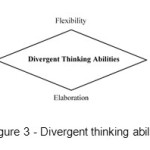 |
Figure3: Divergent thinking abilities |
These factors correspond well with the views of Craft (2005) and Pink (2005) who are of the opinion that originality and imagination are important features of creativity in an academic domain. Divergent thinking people do not behave like others in thought and deed. But they have differences with others and get away from norms and habits. Their methods are new and innovative. So divergent thinking is moving away from traditions, norms and habits, and convergent thinking is becoming close to them. Divergent thinking is synonym with creativity and creativity tests are often divergent thinking tests (Sadeghi and Raeesi, 2010). It can be said that convergent thinking is constantly trying to stop thinking. A person who thinks convergent always tries to solve problems in order not to think about it but a person who thinks divergent is trying to think wider and his final goal is to reach newer locations. In this situation the more the person thinks, the wider the issue becomes. This issue is a result of right brain activity that creative people are more expertise in this field. One of the most important places where creative people can be fostered are educational environments specially schools. Also teachers are people who can cause development of students' creativity or vice versa, can cause failure of students' creativity by using wrong teaching methods. Torrance believes that human civilization is indebted of man's creative thought and it would be impossible to survive without taking advantage of creativity, the highest function of human's mind. In current situation creativity is not only a necessity but also a condition for survival. So it is necessary for educational system to emphasize on people's training in direction of making them able to solute unpredictable problems creatively (Kazemi and Jafari, 2008). It is suggested to use right brain in art field that creativity has a great place, against other fields that their priority is using left brain.
Materials and Methods
State of Issue
A lot of scientists believe that human civilization is based on creativity, so survival and excellence of society depend on the much of paying attention to foster it. But creativity has no place not only in society but also in scientific communities yet, and because of this reason there is no course in Iran's universities in order to teach creativity. Its result is current situation that can be seen among graduates – people have specialty but they cannot compete with others in the world of career (Samadaghaei, 2004). Scientifics believe that fostering students' creativity can be a solution for this basic need of Iran.
Research Goals
The goal of this research is explaining the relationship between art and creativity through the recognition of impact of artistic environments on human's creativity.
Research Questions:
- Does the use of artistic forms in school (student's classrooms) effect on the creativity of students? 2. What are the effects of use of art in classrooms on the creativity of the students? and How can be interpreted?
Research Method
In this research empirical and semi-empirical methods are used. Method of data collection is using archival sources, surveying the documentations and field studies. Thus in theoretical part is tried to pay attention to all aspects of the subject by use of archival methods and surveying the documentations and proposing different views. In case study part, three groups of variables are considered that two of them have been manipulated in order to discover casual relationships (effect of art on creativity). It is used of statistical techniques with the help of Pearson correlation test for doing different phases of this research (Groat and Wang, 2005).
Research Approach
The approach of this research is anthropology of art with an emphasis on sociology of education. This view is a result of having a cultural view to the students, as a concepts learner human, with the use of art media, as a tool of enhancing students' creativity and ability.
Society and Sample of Research
Society of research is included of all secondary schools in Tehran. Sample is a secondary school that is selected randomly in Tehran city. Selected school is a boys' school of eleventh region of Tehran city. Three classes among second grade of school are selected and tested.
Test
Test Tools
According to Alavy's thesis, one of the most practical tools for measuring creativity is "Torrance Test of Creative Thinking." It is include of a complex set of verbal, visual and auditory assignments that gives some scores in the fields of fluency, originality, abstractness, elaboration and resistance to premature closure. Data of this test don’t have a considerable validity and reliability, and change from test to another test. Torrance Test of Creative Thinking (Torrance, 1974) is composed of twelve tests and is divided into three parts of verbal, visual and auditory tests that in order are called creative thinking with words, creative thinking with pictures and creative thinking with sounds. Torrance explains that these tests are usable from kindergarten to graduate courses. Visual test has been used in this research because verbal and auditory tests require the use of different words, phrases and sounds of animals. These words and phrases are often cultural affected issues and it is needed to do extensive works on the normalization of these words and sentences. Part of creative thinking with pictures consists of three activities. In the first section (Test of Imagination), test subjects should consider a curved shape and uses it as a starting point, and thus draws an unusual picture that will tell an interesting story. In part of test of imagination, test subjects should draw a picture by use of some given lines. Base on test of imagination, five complete scores are considered for fluency, originality, abstractness, elaboration and resistance to premature closure (Alavy, 2005, 45).
Test Procedures
In this research three classrooms among all boys' second grade of secondary schools in eleventh region of Tehran city have been selected randomly. Torrance test has been done in two phases in these classrooms. First, before any actions, Torrance test was conducted in each three classrooms. Students' creative scores are registered by testers, and then some changes happen on environment in two classes. In one of these two classrooms just visual-artistic changes are done; and in other one in addition of those changes, artistic activities and introducing artistic concepts to the students are done (these activities are included: art crafts, painting and …). Finally after two months Torrance test is repeated. In this phase as well as before, students' scores are registered. Observing the changes between primary test and final one, and comparing the experimental samples (a sample in which environmental changes caused) with control sample (a sample in which no changes caused) can be a guide to answer the research questions. The summary of the test has been brought in table 1.
Table1: Summary of experimental groups and control group
|
Random Sample |
Post-Test |
Independent Variable |
Pre-Test |
|
|
R |
T2 |
X1 |
T1 |
First Group |
|
R |
T2 |
X1, X2 |
T1 |
Second Group |
|
R |
T2 |
T1 |
Control Group |
The above table expresses these points: 1. There are three groups. 2. All the groups are measured at a time, before acting the independent variable. 3. All the groups are measured at a time, after acting the independent variable. 4. Test subjects were categorized randomly. 5. Two groups are subject to independent variables (the first group has one independent variable and the second group has two ones), but these independent variables not being acted for control sample.
Results and Discussion
In Torrance test, four activities are considered the main axes of the measuring creativity, include:
- Originality: the ability to generate innovative, unusual and fresh ideas.
- Flexibility: the ability to generate various ideas and ways.
- Elaboration: the ability of paying attention to details.
- Fluency: the ability to generate many ideas.
With the help of these four activities and TTCT manual can do the grading. In this test by performing two phases and obtaining results can calculate the outcome by subtracting the results of these two phases and summing the achieved differences. The progress percentage can be achieved by dividing the obtained outcomes on outcomes of first phase of test. As the following table shows the progress percentage of class C is more than two other classes. This percentage in class A is more than class B, but their difference is very small. The following table shows the changes before and after doing the test in each three classrooms in activity of originality (Table 2, Figure 4).
Table2: Comparison of originality in 3 classrooms
|
Class C |
Class B |
Class A |
Originality |
|||
|
Progress (%) |
Outcome C |
Progress (%) |
Outcome B |
Progress (%) |
Outcome A |
|
|
31.6 |
269 |
19.7 |
154 |
20.95 |
142 |
|
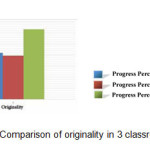 |
Figure4: Comparison of originality in 3 classrooms |
According to the results of the following table can mention that the percentage of flexibility in class B (9.63) is more than class A (0.54), and in class C (14.46) is more than two other classes. It means that creativity has had more progress in a class (class C) that has been focused on it more (Table 3, Figure 5).
Table3: Comparison of flexibility in 3 classrooms
|
Class C |
Class B |
Class A |
Flexibility |
|||
|
Progress (%) |
Outcome C |
Progress (%) |
Outcome B |
Progress (%) |
Outcome A |
|
|
14.46 |
720 |
9.36 |
545 |
0.54 |
30 |
|
 |
Figure5: Comparison of flexibility in 3 classrooms |
The numbers of the following table indicate that in experimental groups (classes B and C) progress percentage of creativity is more than the other class that has been controlled but no changes has been done on it (class A) (Table 4, Figure 6).
Table4: Comparison of elaboration in 3 classrooms
|
Class C |
Class B |
Class A |
Flexibility |
|||
|
Progress (%) |
Outcome C |
Progress (%) |
Outcome B |
Progress (%) |
Outcome A |
|
|
89.51 |
391 |
57.49 |
477 |
20.81 |
149.99 |
|
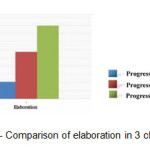 |
Figure6: Comparison of elaboration in 3 classrooms |
As the fluency table will show, by comparing the progress percentages can note results similar to the previous table (Table 5, Figure 7).
Table5: Comparison of fluency in 3 classrooms
|
Class C |
Class B |
Class A |
Fluency |
|||
|
Progress (%) |
Outcome C |
Progress (%) |
Outcome B |
Progress (%) |
Outcome A |
|
|
72.47 |
373 |
46.28 |
190 |
22.55 |
111 |
|
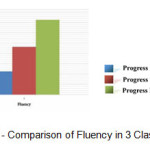 |
Figure7: Comparison of Fluency in 3 Classrooms |
The following table shows that students' creativity in class C is more than the other two classes in all abilities after the second phase of the test. This difference is meaningful; in other words, creativity in class C that both visual and artistic activities changes were done is much more, and in class B it has decreased in just one activity (originality) and has increased in other activities (flexibility, elaboration and fluency) (Table 6). The graph of this table also can be seen in below (Figure 8):
Table6: Comparison of changes before and after Torrance test
|
Progress Percentage of C |
Outcome C |
Progress Percentage of B |
Outcome B |
Progress Percentage of A |
Outcome A |
Ability |
No. |
Final Outcome |
|
31.6 |
269 |
19.7 |
154 |
20.95 |
142 |
Originality |
1 |
|
|
14.46 |
720 |
9.63 |
545 |
0.54 |
30 |
Flexibility |
2 |
|
|
89.51 |
391 |
57.49 |
477 |
20.81 |
149.99 |
Elaboration |
3 |
|
|
72.47 |
373 |
46.28 |
190 |
22.55 |
111 |
Fluency |
4 |
|
|
52.01 |
438.25 |
33.27 |
341.5 |
16.21 |
108.24 |
Average |
5 |
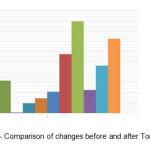 |
Figure8: Comparison of changes before and after Torrance test |
Conclusions
Human in every moment of life in terms of mental and physical health and perfectionism, emerging creativity and achieving to self-esteem levels is affected more by all the environmental conditions and various environments that are faced to them during the growth and along the way of life. So it can be said that mental and physical health, prosperity of emotional intelligence, quality of life and individual and social ethics is a result of being affected by primary fostering and training spaces and environments. It is important to remind that memorizing contents does not have any interest, but creativity in using these contents plays a more effective role in human progress. Creativity is not limited to certain people and they can create or strengthened it in themselves. In order to achieve this not only should recognize mind and its abilities, but also should be able to design an environment that is encouraging creativity.
It mentioned that the brain is composed of two hemispheres. Activities such as math, verbal communications, logic, analysis and writing by left half and Activities as perception, imagination, understanding color, music, fantasies and dreams by right half of brain are done. When can use both of halves of human brain its efficiency increases dramatically. Many scientists have tried to keep the right half of brain active by use of artistic activities, because 90% of people work with left half of their brain.
In this test we also observed that mental efficiency of students of class C that they had both visual and artistic activities changes, has increased more than class B; and mental efficiency of students of class B has increased more than class A that has no changes in visual and artistic activities. In fact, in this test we first tried to activate right half of brain by making visual changes in class B. People's activity increased with these changes. Then we continued to the activation of the right half of their brain by doing artistic activities in addition of visual changes in class C. Finally, the results showed that artistic activities can flourish mental talents and foster people's creativity (activation of right hemisphere in addition of left one).
Studies confirm the principles outlined in the literature, and insist on the relationship between environment and creativity. The results of quantitative tests indicate that presence of students in artistic environments has increased their creativity. So it can be predicted a meaningful relationship between artistic atmosphere of classroom and increasing creativity. Research results clearly insist on using artistic activities as a significant factor in making better the quality of classrooms.
References
- Alavy, S. K. The Study of Developmental Creativity Potential in Children and the Effects of Life Skills Training on Its Enhancement, PhD dissertation, Tarbiat Modares University, Tehran, 45 (2005)
- Behruzi, N. Zarurat-e Parvaresh-e Khalaghiat dar Amuzesh-e Ali. Iranian Journal of Engineering Education, (29) 81-95 (1995)
- Cheraghcheshm, A. An Investigation into Influence of Creativity-Based Teaching Methods on Students' Education and Learning. Biquaterly Journal of Islamic Education, 5, 7-36 (2007)
- Craft, A. Creativity in Schools (Routledge Publishers, 2005)
- Gale Group. Gale Encyclopedia of Psychology. Retrieved 24 September 2013 from: http://www.findarticles.com/cf_dls/g2699/0004/2699000443/p1/article.jhtml (2001)
- Groat, L. and Wang, D. Architectural Research Methods (John Wiley and Sons, 2005)
- Guilford, J. P. Can Creativity Be Developed? Art Education, 11, 3-7 (1958)
- Guilford, J. P. Traits of Creativity, Creativity and Its Cultivation (Harper & Brothers, 1956)
- Hojat, E. Creative Education: a New Experience. Honar-Ha-Ye-Ziba, 18, 25-36 (2004)
- Hosseini, A. Parvaresh-e Khalaghiat az Tarigh-e Honar. Khalaghiat va Noavari, 8 (1) (2004)
- Hosseini, S. H. Tafakor-e Khalagh Mabna-ye Shive-ha-ye Amuzeshi-e Piambar (PBUH). Daneshgah-e Eslami, 38, 24 (2008)
- Kazemi, Y. and Jafari, N. Teachers' Characteristics and Activities as Impediments to Students' Creativity. New Thoughts on Education, 1, 177-191 (2008)
- Mackinnon, D. W. Personality and the Realization of Creative Potential. American Psychologist, 20, 273-281 (1965)
- Mahdavinejad, M. Creativity and Innovative Educational Process in Architectural Design. Honar-Ha-Ye-Ziba, 21, 57-66 (2005)
- Meintjes, H. and Grosser, M. Creative Thinking in Prospective Teachers: the Status Quo and the Impact of Contextual Factors. South African Journal of Education, 30, 361-386 (2010)
- Morgan, S. and Foster, J. Creativity in the Classroom. Gifted Education International, 14, 29-43 (1999)
- Mosadad, S. H. Importance and Fundamental of Selection for Products. International Journal of Industrial Engineering and Production, 6, 45 (2008)
- Pink, D. H. A Whole New Mind: Moving from the Information Age into the Conceptual Age (Allen & Unwin, 2005)
- Pirkhaefi, A. Parvaresh-e Khalaghiat (Kanoon-e Parvaresh-e Fekri-e Koodakan va Nojavanan, 2000)
- Raeesdana, F. Barnamerizi-e Amuzeshi-Darsi va Modiriat-e Kelas-e Dars. Roshd Magazine, 6, 21 (2009)
- Sadeghi, M. and Raeesi, M. Erae-e Model-e Mafhoomi Baraye Sanjesh-e Khalaghiat. Tose'e Ensani-e Polis, 3, 97-112 (2010)
- Safe, H. The Studying of Painting Instruction Influence Based on Opening Method in Training of Children's Creativity about Boys Who Are 10 Years Old in 8 and 15 Region of Tehran, Master's thesis, Tarbiat Modares University, Tehran, 57 (1995)
- Samadaghaei, J. Creativity the Essence of Entrepreneurship (Daneshgah Tehran, 2004)
- Seyyedjavadin, S. R. and Karami, A. Shokufaei-e Khalaghiat-e Karbordi. Tadbir Magazine, 183, 14 (2007)
- Shafaee, M. and Madani, R. Designing Patterns of Children Educational Spaces Based on Creativity Model. Journal of Technology of Educaion, 3, 215-222 (2010)
- Soleymani, A. The Apple of Creativity: Cognition and Education of Creative Thinking (Fara Ravan, 2006)
- Sternberg, R. J. What Is the Common Thread of Creativity? Its Dialectical Relation to Intelligence and Wisdom. American Psychologist, 56, 360-362 (2001)
- Torrance, E. P. Torrance Tests of Creative Thinking: Norms-Technical Manual (Scholastic Testing Service, 1974)
- Torrance, E. P. Torrance Tests of Creative Thinking: Scoring Manual for Figural Test (University of Minnesota, 1992)
- Valqui Vidal, R. V. Creativity and Problem Solving (The Technical University of Denmark, 2003)
- Wallace, B. Creativity: Some Definitions, the Creative Personality, the Creative Process, the Creative Classroom. Gifted Education International, 2, 68 (1986):






